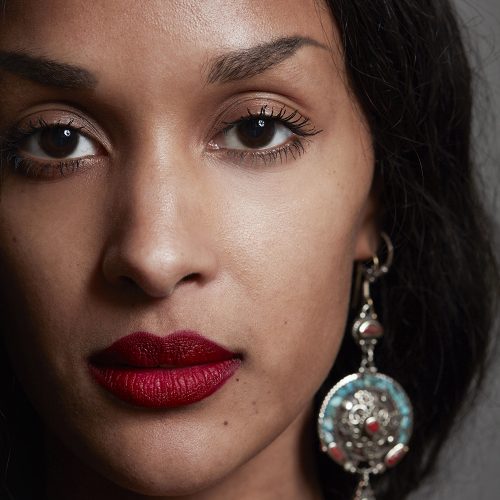When you meet Valérie, you are drawn in by her infectious energy, her sparkling eyes which shine behind a mass of curly black hair, and a smile so huge that you can see her gums! Incidentally it makes me notice that she has brown gums… At that moment it makes me question my own ginigval heritage… (I would check later in the rearview mirror. Conclusion: mine are pink…)
She welcomes me to her place, in a black dress with red lips, her arms heavy with stone bracelets, precious protective talismans… Emerging through the vapours of essential oils is the smooth soul voice of Erykah Badu; we get comfortable with green tea and pastries before us… It’s my 1st Mixologies interview! I feel a little nervous but Valérie, this generous and strong women who has her own set of problems, her words are reassuring, the kind that encourage you… Her own particular era emanates thoughts that inspire you and give you perspective. She confides in me that she has been battling a serious illness for several years, something I could’ve never imagined for a single moment… For all that she hasn’t lost any of her fighting spirit and tells me about the technique of positive visualisation, of the confidence she puts into every project, and her optimism commands respect, at least mine anyway…

- First name : Valérie
- Age : “Do we have to ?”
- Profession (s) : Professor of applied arts & design in a high school
- Mix : West Indies x Spain x France
- Lives in : Paris
Miscegenation ?
When I ask her about her vision of racial mix Valérie talks about LOVE: “Do we need to define it? More than anything else it is about two people who meet and who fall in love… and then have children.”
It’s that simple. I find her romantic.
So it is a story of love that she tells me with passion, the story of how her parents met. In 64, her mother, from a Spanish family of winemakers living in southern France near Béziers, was sent to Paris to a home for girls looking for work.
She was 18 when she saw the dark face of the 1st black person she had ever seen in her life. It was love at first sight! He, a dandy who had come to France to study, would become agent de maîtrise.
The wedding wasn’t long in coming: in 65, blacks and whites celebrated the union of the two lovers in a village in France’s Languedoc region. The whole village was of there: there are so few blacks in the region! Two girls would be born of this union: Valérie and her sister. Their parents are still together…
“Spanish-West Indian hybrid”
“Being mixed? A source of tolerance and openness above all!”
Valérie seems to be a perfectly balanced cocktail with fruity and intense flavours! As a child she didn’t see colours, didn’t hear the sing-songy accents that filled her home. Not by any means a source of weakness: “Two genetic heritages that are so far apart, it can only be good! No problems with consanguinity!” This scientific approach that had never even crossed my mind instantly convinces me.
And also, “by intermixing with both worlds we know how to take things into consideration. We don’t judge…” Valérie refuses stereotypes. She thinks that we will all be racially mixed one day and that contrary to the words of our precious Nadine Morano (a French Republican politician), France isn’t and will never be a country of white race, the French will be of all colours and everyone will be used to it!
Pourtant she shares a funny anecdote showing the contradictions of human nature: the birth of his son ! (She has two beautiful children, boy and girl) « He was white … » Stunned, Valérie doesn’t understand why her son is not brown like her…
« But… he is white !!!!??? Quick, take of his diaper so I can see if his b**** are pink or brown!”*
*To have an idea of the future color of the baby’s skin

Ti’punch or sangria ?
She feels very close to the Guadeloupean community but she is also close to her southern culture with its land and its vineyards (even if she did admit to me that she hates wine). She extols the values shared by her Spanish and Guadeloupeean family: Warmth/Acceptance, the culture of receiving.
Although Valérie doesn’t speak Spanish, she understands Creole perfectly but can’t for one second imagine using it to communicate: “It doesn’t come out…Impossible!” When people speak Creole to her in the West Indies, she replies in French.
As an adult she says she naturally grew closer to mixed cultural environments. Indeed she teaches in Saint Denis, a city she has a particular fondness for because of its racial diversity.
“Nappy” is beautiful
“Used to her face”, Valérie doesn’t think twice about her visual appearance. It’s others who remind her of her origins by often attributing her with some imaginary ancestry… They take her for a Moroccan, they regularly speak Arabic to her, whereas her sister passes for a tanned Caucasian coming back from a ski trip! These misconceptions don’t seem to bother her, she plays with them, she even laughs at them!
Valérie doesn’t look like her parents and especially not like her mother, who has platinum blond hair and green eyes. As a child she asked herself why there weren’t any black dolls. I think back of the terrifying video called “the black doll test” which shows how from a very young age children (whether they are black or white) are conditionned to the systematic devaluation of black people…
Later, Valérie passionately led battles that she personified; the first concerning the natural hair of black people! We talked for a long time about this topic that is very important to her. She mentions the “Nappy” (Natural & Happy) movement. “Why would straight hair be prettier than curly hair?”
Goodbye Beyoncé weaves and mops of hair! !
Valérie encourages and highlights her students who “overcome” and fight for capillary revolution! At that moment she runs her hand through her hair and shows me her beauty trick: broccoli oil to hydrate her soft curls.
Another subject close to her heart: curves and roundness.
This voluptuous creative mind makes her clothes and wants to flatter the curves of the rounder woman’s body! An ode to Kallipygos beauty! Her first job was actually as a fashion designer.
Brown skin lady
Today, when she finds herself in a conflictual situation with others, she asks herself if, really, “could it be linked to this…” But this explanation only comes up as a last resort. Her parents, whose union was incidentally very well received by their respective families, were more directly confronted with racism. One day her mother, who worked at Elizabeth Arden, was reproached for having a black man come get her at work. One lunchtime, she quit.
As for Valérie, she tells me the story of how one day when she was in the car with her sister a driver screamed out “Dirty niggers!” An unaffected and reciprocal burst of laughter ensued for the sisters in the car, so much did they consider the insult to be improbable.
As a child, however, she reveals that the colour of her skin was a great source of pain for her; raised in Franconville in the Val d’Oise department (north of Paris), she was the target of jokes and rejection.
To the children who didn’t want to play with her she would cry out: “But I’m not black, I’m brown!”
It is undoubtedly one of the first experiences that forged the committed and full of fight character that is Valérie…
To the children who didn’t want to play with her : “But I’m not black, I’m brown!”










